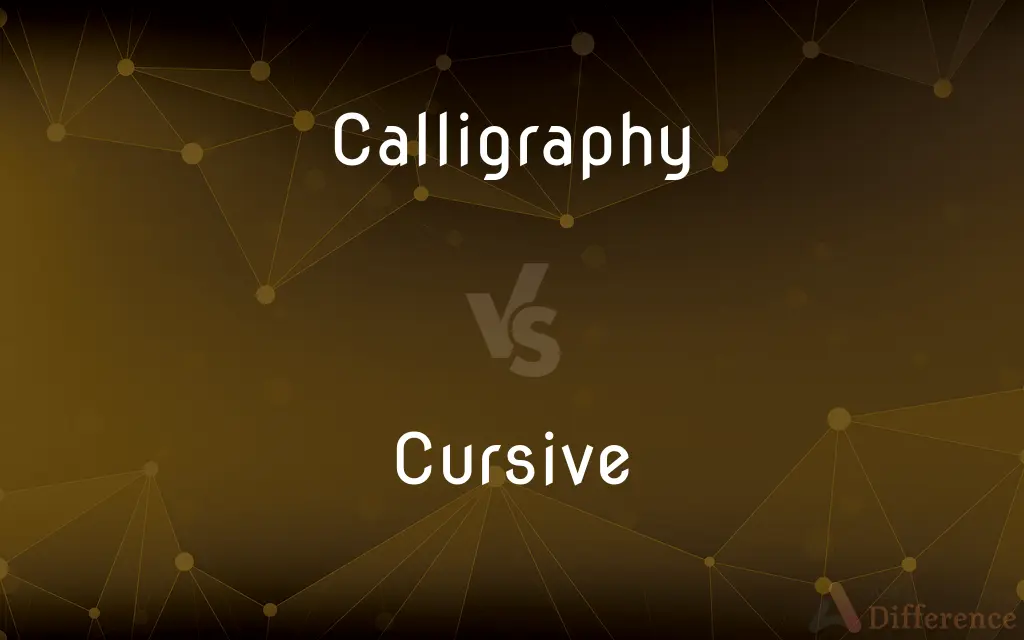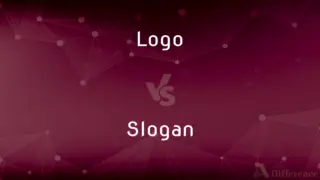Calligraphy vs. Cursive — What's the Difference?
By Maham Liaqat & Urooj Arif — Updated on May 21, 2024
Calligraphy is the art of beautiful, decorative handwriting often used in formal documents, while cursive is a style of flowing, joined-up handwriting used for faster writing.

Difference Between Calligraphy and Cursive
Table of Contents
ADVERTISEMENT
Key Differences
Calligraphy is an art form where each letter is crafted with care and attention to aesthetics, often using special pens or brushes. Cursive, on the other hand, is a practical handwriting style designed for speed and efficiency, with letters connected for fluidity.
Calligraphy typically involves a variety of strokes and embellishments, making it visually striking and suited for invitations or certificates. Cursive, by contrast, prioritizes smooth, continuous lines, making it faster to write and suitable for everyday note-taking and correspondence.
In calligraphy, the emphasis is on the form and design of each individual letter, with a focus on maintaining uniformity and beauty. Whereas in cursive, the emphasis is on the legibility and speed of writing, with letters often taking on a more simplified and connected form.
Calligraphy often requires specialized tools such as nib pens, brushes, and ink, providing a wide range of styles like Gothic, Italic, or Copperplate. In contrast, cursive writing is typically done with standard writing instruments like pens or pencils, focusing more on functionality than style.
Comparison Chart
Purpose
Decorative, artistic handwriting
Practical, efficient handwriting
ADVERTISEMENT
Tools
Special pens, brushes, inks
Standard pens or pencils
Style
Various styles like Gothic, Italic
Generally one consistent style
Letter Formation
Individual, often elaborate
Connected, simplified
Usage
Formal documents, art pieces
Everyday writing, notes
Compare with Definitions
Calligraphy
Hand lettering with special tools.
Calligraphy pens produce varying line thicknesses.
Cursive
Connected letter formation.
Cursive writing helps in writing more quickly.
Calligraphy
Artistic writing style.
The wedding invitation was adorned with elegant calligraphy.
Cursive
Standardized handwriting.
Many schools teach cursive in early grades.
Calligraphy
Visual art form.
The museum displayed ancient calligraphy scrolls.
Cursive
Script with joined letters.
His cursive handwriting is neat and legible.
Calligraphy
Calligraphy (from Greek: καλλιγραφία) is a visual art related to writing. It is the design and execution of lettering with a pen, ink brush, or other writing instrument.
Cursive
Flowing handwriting style.
She writes her journal entries in cursive.
Calligraphy
The art of decorative handwriting.
Cursive
Cursive (also known as script, among other names) is any style of penmanship in which some characters are written joined together in a flowing manner, generally for the purpose of making writing faster, in contrast to block letters. Cursive handwriting is very functional, and is intended to be used in everyday writing.
Calligraphy
Works in decorative handwriting considered as a group.
Cursive
Having the successive letters joined together
Cursive writing.
A cursive style of type.
Calligraphy
Handwriting.
Cursive
A cursive character or letter.
Calligraphy
(uncountable) The art or practice of writing letters and words in a decorative style; the letters and words so written.
Cursive
A manuscript written in cursive characters.
Calligraphy
(countable) Any such style of decorative writing.
Cursive
(Printing) A type style that imitates handwriting.
Calligraphy
(countable) A document written in decorative style.
Cursive
Running; flowing.
Calligraphy
Fair or elegant penmanship.
Cursive
(of writing) Having successive letters joined together.
Calligraphy
Beautiful handwriting
Cursive
(grammar) Of or relating to a grammatical aspect relating to an action that occurs in a straight line (in space or time).
Calligraphy
Decorative handwriting.
She practices calligraphy to create beautiful greeting cards.
Cursive
(countable) A cursive character, letter or font.
Calligraphy
Skillful and artistic letter formation.
Learning calligraphy requires patience and precision.
Cursive
(countable) A manuscript written in cursive characters.
Cursive
(uncountable) Joined-up handwriting.
Cursive
Running; flowing.
Cursive
A character used in cursive writing.
Cursive
A manuscript, especially of the New Testament, written in small, connected characters or in a running hand; - opposed to uncial.
Cursive
Rapid handwriting in which letters are set down in full and cursively connected within words without lifting the writing implement from the paper
Cursive
Having successive letter joined together;
Cursive script
Cursive
Practical for fast writing.
Taking notes in cursive can save time.
Common Curiosities
What tools are used in calligraphy?
Calligraphy typically uses special pens, brushes, and ink.
What tools are used in cursive writing?
Cursive writing is usually done with standard pens or pencils.
Is cursive used for everyday writing?
Yes, cursive is often used for everyday writing and note-taking.
What is cursive writing?
Cursive writing is a style of handwriting where the letters are connected for faster writing.
How does calligraphy differ from regular handwriting?
Calligraphy is more artistic and decorative compared to regular handwriting.
How does cursive differ from print handwriting?
Cursive connects letters together, while print handwriting separates them.
Is calligraphy considered an art form?
Yes, calligraphy is considered a form of visual art.
Is calligraphy used for everyday writing?
No, calligraphy is mainly used for decorative and formal purposes.
What is calligraphy?
Calligraphy is the art of creating decorative handwriting or lettering with a pen or brush.
Is cursive writing the same across different languages?
No, cursive styles can vary between languages.
Is cursive writing faster than print writing?
Generally, yes, cursive writing can be faster than print writing.
Can anyone learn calligraphy?
Yes, with practice and the right tools, anyone can learn calligraphy.
Can anyone learn cursive writing?
Yes, cursive writing is often taught in schools and can be learned by anyone.
What styles are common in calligraphy?
Common styles include Gothic, Italic, and Copperplate.
Why is cursive writing important?
Cursive writing is important for developing fine motor skills and can improve writing speed.
Share Your Discovery

Previous Comparison
Logo vs. Slogan
Next Comparison
Airsoft vs. PaintballAuthor Spotlight
Written by
Maham LiaqatCo-written by
Urooj ArifUrooj is a skilled content writer at Ask Difference, known for her exceptional ability to simplify complex topics into engaging and informative content. With a passion for research and a flair for clear, concise writing, she consistently delivers articles that resonate with our diverse audience.
















































